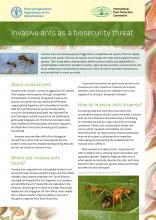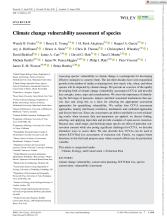Climate change vulnerability assessment of species


Climate Change Resilience, BRB
Available Online
Akçakaya, H. Resit
,
Bickford, David
,
Carr, Jamie A.
,
Foden, Wendy B.
,
Garcia, Raquel A.
,
Hoffmann, Ary A.
,
Hole, David G.
,
Huntley, Brian
,
Martin, Tara G.
,
Pacifici, Michela
,
Pearce‐Higgins, James W.
,
Platts, Philip J.
,
Stein, Bruce A.
,
Thomas, Chris D.
,
Visconti, Piero
,
Watson, James E. M.
,
Wheatley, Christopher J.
,
Young, Bruce E.
2018
Assessing species' vulnerability to climate change is a prerequisite for developing effective strategies to conserve them. The last three decades have seen exponential growth in the number of studies evaluating how, how much, why, when, and where species will be impacted by climate change. We provide an overview of the rapidly developing field of climate change vulnerability assessment (CCVA) and describe key concepts, terms, steps and considerations. We stress the importance of identifying the full range of pressures, impacts and their associated mechanisms that species face and using this as a basis for selecting the appropriate assessment approaches for quantifying vulnerability. We outline four CCVA assessment approaches, namely trait?based, correlative, mechanistic and combined approaches and discuss their use. Since any assessment can deliver unreliable or even misleading results when incorrect data and parameters are applied, we discuss finding, selecting, and applying input data and provide examples of open?access resources. Because rare, small?range, and declining?range species are often of particular conservation concern while also posing significant challenges for CCVA, we describe alternative ways to assess them. We also describe how CCVAs can be used to inform IUCN Red List assessments of extinction risk. Finally, we suggest future directions in this field and propose areas where research efforts may be particularly valuable.








